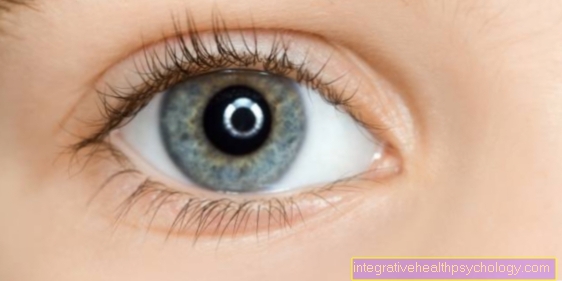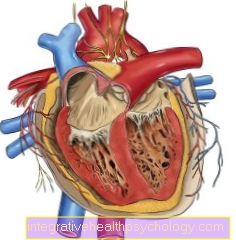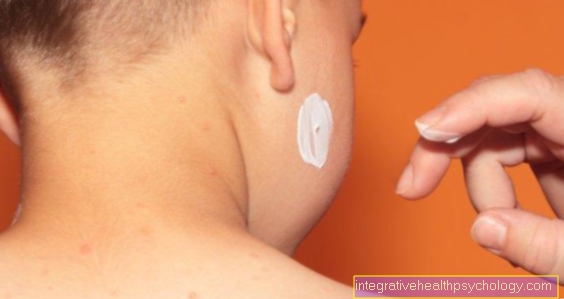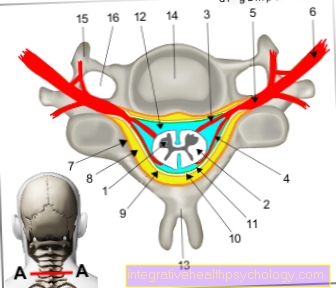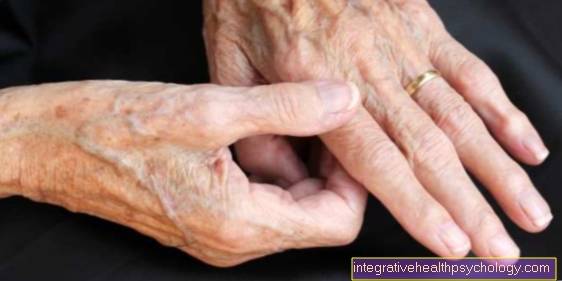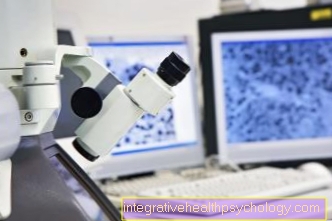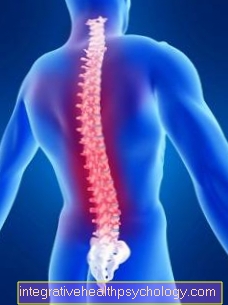Burning in the upper back
What is a burning sensation in the upper back?
The burning sensation in the upper back generally describes a discomfort. This can be felt on the surface, under the skin or it can also be felt more deeply. In addition, the burning sensation is also considered a pain quality.
The burning sensation is therefore often referred to as burning pain by those affected. The burning sensation is usually difficult to localize and extends over a large area. If it comes to burning pain, one also speaks of so-called neuropathic - that is, pain emanating from the nerves. If a burning sensation occurs in the upper back, a doctor should be consulted to clarify the cause.
Do you have pain in your back? - Then learn more about it in our article Back pain in the upper back
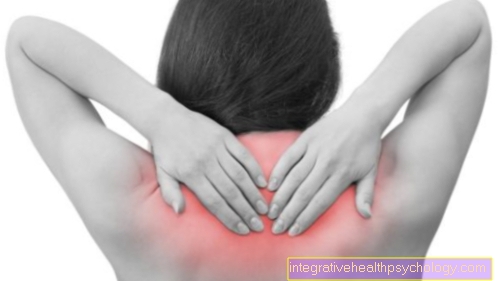
Causes of burning in the upper back
Many different causes can trigger an upper back burning sensation. In general, the burning sensation can be caused by muscular, bony or organic diseases.
Muscular or bony injuries, especially if nerves are irritated, can cause a burning sensation. For example, muscular tension in the upper back can manifest itself as a burning sensation.
Injuries to the ribs, for example after an accident, can cause nerve irritation and consequently a burning sensation. If the burning pain in the upper back occurs only on one side, shingles (herpes zoster) can be responsible for the burning.
An urgent cause of a burning sensation in the chest or upper back that requires clarification is what is known as angina pectoris. This is a symptom that occurs when the heart does not get enough oxygen. Since there is a risk that it could develop into a heart attack, this cause of the burning sensation should be urgently ruled out.
Diseases of the lungs such as bronchitis or pneumonia can also express themselves as burning pain. In very rare cases, sudden, severe, and almost tearing pain is a ruptured aortic aneurysm. An aneurysm describes a bulging of the vessel wall. In an aortic aneurysm, the main artery is affected. In rare cases this bulge can tear open.
Treating an upper back burning sensation
Treatment depends on the underlying cause. For muscular tension or lumbago, pain therapy should be used. Supportive physiotherapy and, later on, back training to strengthen the muscles are also appropriate.
Bronchitis and pneumonia should be treated symptomatically with bed rest and plenty of fluids. Painkillers and antipyretic drugs can also be taken. If the inflammation is caused by bacteria, antibiotic therapy is unavoidable.
On the one hand, shingles is treated with local creams that have anti-inflammatory effects. On the other hand, it is important to treat the pain with painkillers such as ibuprofen, paracetamol or, depending on the intensity of the pain, with weakly effective opioids.
In some cases, for example in patients over 50 years of age, antiviral therapy with acyclovir is appropriate. If it is an attack of angina pectoris, an acute treatment is usually given with nitroglycerin spray, which is sprayed under the tongue. This agent dilates the vessels in the heart and thus ensures better blood circulation. In the following - especially after the first attack - permanent therapy with a blood thinner such as ASA should take place.
A ruptured aortic aneurysm, on the other hand, requires urgent surgical treatment.
In addition, other underlying diseases such as high blood pressure, diabetes mellitus or elevated fat levels should be treated with medication. It is also important to change your diet, lose weight, abstain from nicotine and exercise enough.
Do you want to improve your lifestyle? - Then read the following articles from us:
- Lose weight by changing your diet
- Healthy eating
- How to quit smoking
Appointment with a back specialist?

I would be happy to advise you!
Who am I?
My name is dr. Nicolas Gumpert. I am a specialist in orthopedics and the founder of .
Various television programs and print media report regularly about my work. On HR television you can see me every 6 weeks live on "Hallo Hessen".
But now enough is indicated ;-)
The spine is difficult to treat. On the one hand it is exposed to high mechanical loads, on the other hand it has great mobility.
The treatment of the spine (e.g. herniated disc, facet syndrome, foramen stenosis, etc.) therefore requires a lot of experience.
I focus on a wide variety of diseases of the spine.
The aim of any treatment is treatment without surgery.
Which therapy achieves the best results in the long term can only be determined after looking at all of the information (Examination, X-ray, ultrasound, MRI, etc.) be assessed.
You can find me in:
- Lumedis - your orthopedic surgeon
Kaiserstrasse 14
60311 Frankfurt am Main
Directly to the online appointment arrangement
Unfortunately, it is currently only possible to make an appointment with private health insurers. I hope for your understanding!
Further information about myself can be found at Dr. Nicolas Gumpert
How long does the burn last?
The duration of the symptoms also depends on the underlying cause and of course on timely treatment.
Muscular complaints should subside after a few weeks with proper treatment. Bronchitis or pneumonia last for one to two weeks, depending on the severity.
If an angina pectoris attack occurs, it will in most cases be over after 10 minutes, but can occur again at any time with renewed physical exertion and without adequate treatment. It is important that shingles is treated with painkillers as soon as possible. In general, the disease can take several weeks to heal completely. However, there is a risk of so-called post-zoster neuralgia, in which the pain can persist for months after the shingles if treatment is not timely.
diagnosis
It is important that a burning sensation in the back is clarified by a doctor in order to rule out serious causes such as a heart attack.
For this purpose, on the one hand, an anamnesis (questioning by the doctor) is carried out, whereby further information such as accompanying symptoms are requested by the doctor. This is followed by a physical examination, where the heart and lungs should be monitored and the spine and back should be palpated.
If angina pectoris or a heart attack is suspected, an ECG must be recorded immediately, which provides information about a heart disease. If pneumonia is suspected, a chest x-ray should be taken. In the rare case of a ruptured aortic aneurysm and also after accidents in which bony structures can be injured, a CT should be performed.
Concomitant symptomsIf the burning sensation is triggered by muscular problems, those affected usually feel tension in the back for a long time.
If bony injuries - such as to the ribs - are responsible for the pain, mobility in the chest can be restricted and, after accidents, for example, bruises on the affected area can occur.
Shingles is associated with a typical rash: the skin becomes reddened on one side and covered with nodules and papules. The affected skin is also usually very sensitive to touch. In addition, the general condition may be reduced and a fever may occur.
Angina pectoris can turn into a heart attack and can then radiate as a burning sensation not only in the back, but typically and most often in the left arm. It can also lead to shortness of breath, cold sweat and feelings of fear.
If pneumonia or bronchitis is responsible for the burning sensation, it usually results in breath-dependent pain. This can be accompanied by a reduced general condition, fever, cough with sputum and other cold symptoms.
Sharp pain
Sharp pain is often associated with a muscular cause. Those affected can point out the origin of the pain directly.
Such muscular hardening can irritate the nerves and, in addition to the stabbing pain, cause a burning sensation that is more difficult to localize. Lumbago or a herniated disc can also cause sharp pain in the upper back. Furthermore, the pain in bronchitis or pneumonia can be sharp in character.
Chest pain
If the burning sensation can be felt in the chest, muscular problems on the front of the ribs can also be responsible. Also in connection with pneumonia, the burning sensation can not only be limited to the back, but can also be felt in the chest.
However, if the burning sensation occurs after physical exertion, in the cold or during strong emotional stress, angina pectoris should be considered. This is described as chest tightness by those affected, which is described by pain behind the breastbone with frequent radiation to the left arm, feeling of pressure and also pain in the upper back. Angina pectoris is often accompanied by cold sweat, feelings of fear and shortness of breath.
Chest pain can also be caused by inflammation of the heart muscle (myocarditis). Compared to a heart attack, heart muscle inflammation can also affect young people. Heart muscle inflammation is usually triggered by viruses or bacteria, but can also occur in the context of autoimmune diseases such as systemic sclerosis.
Do you have chest pain? - Then read our main article about this Chest pain




